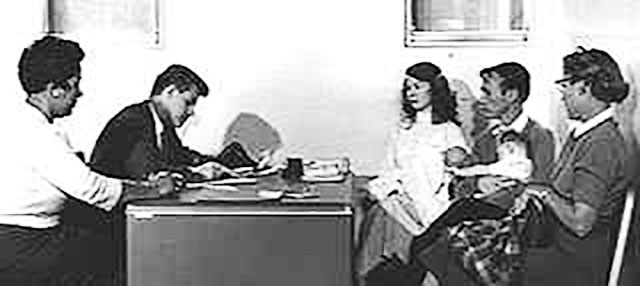Public Attitudes
Two books published in the early 1950s had an enormous impact on the public's perception of mental retardation. Pearl Buck, famous American author and novelist, was awarded the Pulitzer Prize in 1932 and the Nobel Prize in 1938 for The Good Earth, a story of peasant life in China where she lived most of her early years with her missionary parents. Her oldest daughter, Carol, born in the United States, had a developmental disability due to phenyketonuria (PKU). In 1950, The Ladies Home Journal published an article by Buck, entitled "The Child Who Never Grew." Later republished in book form, the article was an account of her daughter Carol, who was placed in New Jersey's Vineland School when she was nine years old, and Buck's efforts to change attitudes and perceptions about persons with disabilities.

In 1953, Dale Evans, who starred with her husband Roy Rogers in a highly popular television series, wrote Angel Unaware. This book is a story about their daughter, Robin, who was born with Down syndrome and died at age two, and Robin's perception of life.
These public acknowledgments of a child with mental disabilities were unprecedented. Here were two of the most famous women in America unashamedly telling the world about their daughters and how they had loved them. Mental retardation had come out of the closet.
It was no coincidence that these books were published at a time when parents of children with mental retardation were beginning to organize: both Pearl Buck and Dale Evans were in touch with other parents and both were motivated by a desire to help them. Their books were a tremendous boon to the newly-organizing parents, emotionally and financially. About ten thousand dollars in royalties from Dale Evans book supported the first national office of the National Association for Retarded Children in New York.
As important as their positive impact was, the books also contributed to the stereotype of the person with mental retardation as an eternal child. They perpetuated the view that such persons – no matter what age – were eternal children of God, capable of doing no wrong, and wanting only to be loved.
An International Parents' Movement
On an international level, a movement by parents was also taking place in England, France, Australia, New Zealand, and the Scandinavian countries. As Gunnar Dybwad noted, "Spontaneously, we had a worldwide revolution without really knowing what started it. They all said at the same time 'enough is enough'. And yet there was not one leader, not one movie or book, not one happening that affected everyone. In various countries, it started in various ways. By the end of the 1950s, an international parents' movement was well underway.
In 1960, the European League of Societies for the Mentally Handicapped was formed, an early name of the organization that advocated for the rights and full inclusion of persons with intellectual disabilities. In1969, the League evolved into the International League of Societies for the Mentally Handicapped (ILSMH) and later became known simply as Inclusion International. The organization includes representatives of parent groups, professional organizations, and individuals from all over the world who are "anxious to advance the interests of the mentally handicapped without regard to nationality, race, or creed;" and work to improve the quality of services through an information exchange with experts from all represented countries.
A growing recognition of the rights of persons with intellectual disabilities led to further reform and program development at an international level. Many professional organizations adopted a statement of rights but the most significant statement was entitled the "United Nations Declaration on the Rights of Disabled Persons." This declaration was adopted by the United Nations General Assembly on December 9, 1975.
United Nations General Assembly Declaration on the Rights of Disabled Persons
General Assembly Resolution 3447 (XXX) Adopted December 9, 1975. The Declaration enumerates the following rights:
- The term "disabled person" means any person unable to ensure by himself or herself wholly or partly the necessities of a normal individual and/or social life, as a result of a deficiency, either congenital or not, in his or her physical or mental capabilities.
- Disabled persons shall enjoy all the rights set forth in this Declaration. These rights shall be granted to all disabled persons without any exception whatsoever and without distinction or discrimination on the basis of race, color, sex, language, religion, political or other opinions, national or social origin, state of wealth, birth, and any other situation applying either to the disabled person himself or herself or to his or her family.
- Disabled persons have the inherent right to respect for their human dignity. Disabled persons, whatever the origin, nature, and seriousness of their handicaps and disabilities, have the same fundamental rights as their fellow-citizens of the same age, which implies first and foremost the right to enjoy a decent life, as normal and full as possible.
- Disabled persons have the same civil and political rights as other human beings; article 7 of the Declaration of the Rights of Mentally Retarded Persons applies to any possible limitation or suppression of those rights for mentally disabled persons.
- Disabled persons are entitled to measures designed to enable them to become as self-reliant as possible.
- Disabled persons have the right to medical, psychological, and functional treatment, including prosthetic and other appliances, to medical and social rehabilitation, education, vocational education, training and rehabilitation, aid, counseling, placement services and other services which will enable them to develop their capabilities and skills to the maximum and will hasten the process of their social integration or reintegration.
- Disabled persons have the right to economic and social security and to a decent living. They have the right, according to their capabilities, to secure and retain employment or to engage in a useful, productive and remunerative occupation and to join trade unions.
- Disabled persons are entitled to have their special needs taken into consideration at all stages of economic and social planning.
- Disabled persons have the right to live with their families or with foster parents and to participation in all social, creative or recreational activities. No disabled person shall be subjected, as far as his or her residence is concerned, to differential treatment other than that required by his or her condition or by the improvement which he or she may derive therefrom. If the stay of a disabled person in a specialized establishment is indispensable, the environment and living conditions therein shall be as close as possible to those of the normal life of a person of his or her age.
- Disabled persons shall be protected against all exploitation, all regulations and all treatment of a discriminatory, abusive, or degrading nature.
- Disabled persons shall be able to avail themselves of qualified legal aid when such aid proves indispensable for the protection of their persons and property. If judicial proceedings are instituted against them, the legal procedure applied shall take their physical and mental condition fully into account.
- Organizations of disabled persons may be usefully consulted in all matters regarding the rights of disabled persons.
- Disabled persons, their families and communities shall be fully informed, by all appropriate means, of the rights contained in this Declaration.
Representative John Fogarty
Although parents were aware of the needs of their families and their children with disabilities, legislators were not well informed about the conditions of public institutions and the overall quality of life for persons who were mentally retarded. Changes began with the efforts of one parent, Mr. Arthur Trudeau. In 1954, Mr. Trudeau invited his friend and former schoolmate, U. S. Representative John Fogarty, to the Christmas party of the Rhode Island Association for Retarded Children.
Representative Fogarty had become one of the nation's leading health experts in Congress, but knew little about the conditions of persons with disabilities. At this party, parents approached him and provided accounts of the lack of services, denial of services, isolation, and segregation. He listened and promised to help. As he opened the annual subcommittee hearings in February 1955, Chairman Fogarty asked his colleagues what they were doing and what they thought might be done on behalf of the millions of children in our country with mental retardation.
In subsequent hearings, Chairman Fogarty raised these same questions before Dr. Leonard Scheele, the Surgeon General, Dr. Pearce Bailey, Director of the National Institute of Neurological Diseases and Blindness, Dr. Martha Eliot, Chief of the United States Children's Bureau, and Dr. Robert Felix, Director of the National Institute of Mental Health. The testimony of these individuals during the Fogarty hearings indicated that very little was being done in the field of field of disabilities. Following these hearings, however, Representative Fogarty was determined to see that federal agencies made up for the decades of neglect.

Mr. Arthur Trudeau
Improve the Institutions
Parents were effective in focusing attention on the needs of persons with disabilities. In many states, money was poured into building new and larger state institutions to meet the increasing demand for services. No longer seen as a menace, the person with mental retardation was now viewed as an ''eternal child," and a patient in need of medical treatment.
These perceptions were reflected in new buildings that were designed to take advantage of discoveries in medicine and operational efficiency. Arthur Hopwood, then President of the American Association on Mental Deficiency (AAMD), embraced the medical model. In 1954, he stated that "medicine, not education, will find the answers." Dr. Hopwood also advised that money for research should take priority over money for services.
Although parents were aware of the abuse that had occurred in institutions, and the need for better education for their sons and daughters, the prevailing attitude was to reform the existing system. Institutions were appropriate, many believed, if only they could be updated and properly staffed.
Parents Provide Services
The large and committed organizations of parents marked the end of a long, tragic era when persons with disabilities were hidden away from view in shame and fear even by their own families. Although the parents' movement was successful in more funds being invested in public institutions, long waiting lists and overcrowded conditions continued to exist.
Many parents simply did not want to place their children in large institutions. What they did want were services, preferably in their own communities. Tired of waiting and, with little or no likelihood of that happening anytime soon, parents took it upon themselves to provide services. In their own homes, church basements, vacant buildings, and newly built schools, a range of services were started, including education, sheltered work, day activity centers, recreation, camps, and various residential models.

1950s Institution
